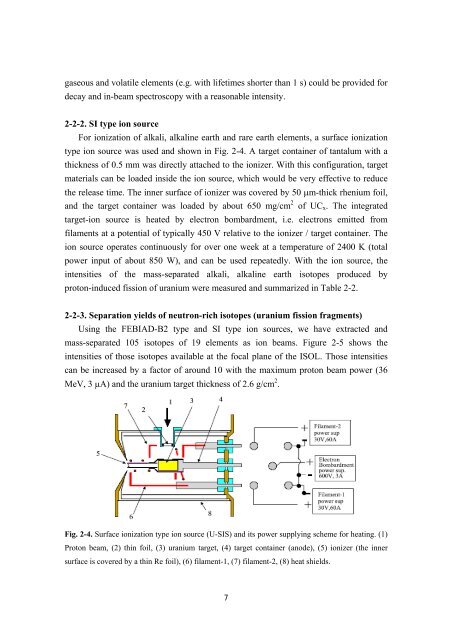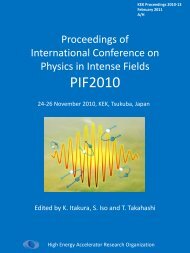TRIAC Progress Report - KEK
TRIAC Progress Report - KEK
TRIAC Progress Report - KEK
You also want an ePaper? Increase the reach of your titles
YUMPU automatically turns print PDFs into web optimized ePapers that Google loves.
gaseous and volatile elements (e.g. with lifetimes shorter than 1 s) could be provided for<br />
decay and in-beam spectroscopy with a reasonable intensity.<br />
2-2-2. SI type ion source<br />
For ionization of alkali, alkaline earth and rare earth elements, a surface ionization<br />
type ion source was used and shown in Fig. 2-4. A target container of tantalum with a<br />
thickness of 0.5 mm was directly attached to the ionizer. With this configuration, target<br />
materials can be loaded inside the ion source, which would be very effective to reduce<br />
the release time. The inner surface of ionizer was covered by 50 µm-thick rhenium foil,<br />
and the target container was loaded by about 650 mg/cm 2 of UCx. The integrated<br />
target-ion source is heated by electron bombardment, i.e. electrons emitted from<br />
filaments at a potential of typically 450 V relative to the ionizer / target container. The<br />
ion source operates continuously for over one week at a temperature of 2400 K (total<br />
power input of about 850 W), and can be used repeatedly. With the ion source, the<br />
intensities of the mass-separated alkali, alkaline earth isotopes produced by<br />
proton-induced fission of uranium were measured and summarized in Table 2-2.<br />
2-2-3. Separation yields of neutron-rich isotopes (uranium fission fragments)<br />
Using the FEBIAD-B2 type and SI type ion sources, we have extracted and<br />
mass-separated 105 isotopes of 19 elements as ion beams. Figure 2-5 shows the<br />
intensities of those isotopes available at the focal plane of the ISOL. Those intensities<br />
can be increased by a factor of around 10 with the maximum proton beam power (36<br />
MeV, 3 µA) and the uranium target thickness of 2.6 g/cm 2 .<br />
Fig. 2-4. Surface ionization type ion source (U-SIS) and its power supplying scheme for heating. (1)<br />
Proton beam, (2) thin foil, (3) uranium target, (4) target container (anode), (5) ionizer (the inner<br />
surface is covered by a thin Re foil), (6) filament-1, (7) filament-2, (8) heat shields.<br />
7













